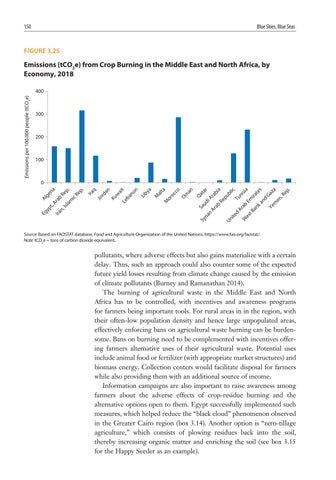150
Blue Skies, Blue Seas
FIGURE 3.25
Emissions (tCO2e) from Crop Burning in the Middle East and North Africa, by Economy, 2018 Emissions per 100,000 people (tCO2e)
400
300
200
100
.
Ye
m
en
,R
ep
za
s
Ga
ira
nd
ka
an
Em
ab W
es
tB
Ar d ite Un
te
sia
ic
Tu
bl
bi
pu Re
ab Ar
n ria Sy
ni
a
r ta
ra iA
Qa
Sa
ud
an
co oc
Om
ta
or
n
ya
al M
M
Lib
t
no
ai w
ba Le
an
Ku
q
rd Jo
p.
Ira
p. ic
Re
Re n,
Isl
am
ab Ira
Eg
yp
t,
Ar
Al
ge
ria
0
Source: Based on FAOSTAT database, Food and Agriculture Organization of the United Nations, https://www.fao.org/faostat/. Note: tCO2e = tons of carbon dioxide equivalent.
pollutants, where adverse effects but also gains materialize with a certain delay. Thus, such an approach could also counter some of the expected future yield losses resulting from climate change caused by the emission of climate pollutants (Burney and Ramanathan 2014). The burning of agricultural waste in the Middle East and North Africa has to be controlled, with incentives and awareness programs for farmers being important tools. For rural areas in in the region, with their often-low population density and hence large unpopulated areas, effectively enforcing bans on agricultural waste burning can be burdensome. Bans on burning need to be complemented with incentives offering farmers alternative uses of their agricultural waste. Potential uses include animal food or fertilizer (with appropriate market structures) and biomass energy. Collection centers would facilitate disposal for farmers while also providing them with an additional source of income. Information campaigns are also important to raise awareness among farmers about the adverse effects of crop-residue burning and the alternative options open to them. Egypt successfully implemented such measures, which helped reduce the “black cloud” phenomenon observed in the Greater Cairo region (box 3.14). Another option is “zero-tillage agriculture,” which consists of plowing residues back into the soil, thereby increasing organic matter and enriching the soil (see box 3.15 for the Happy Seeder as an example).






